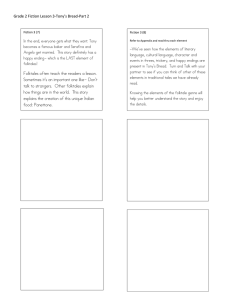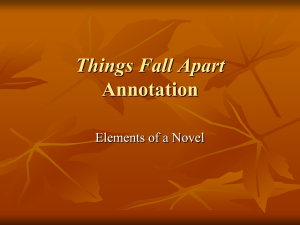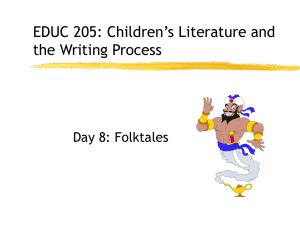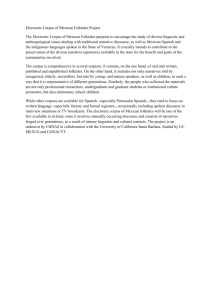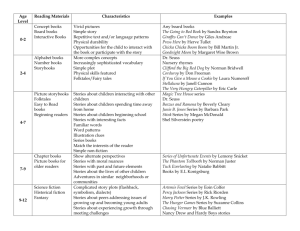The Devil`s Colors: A Comparative Study of
advertisement
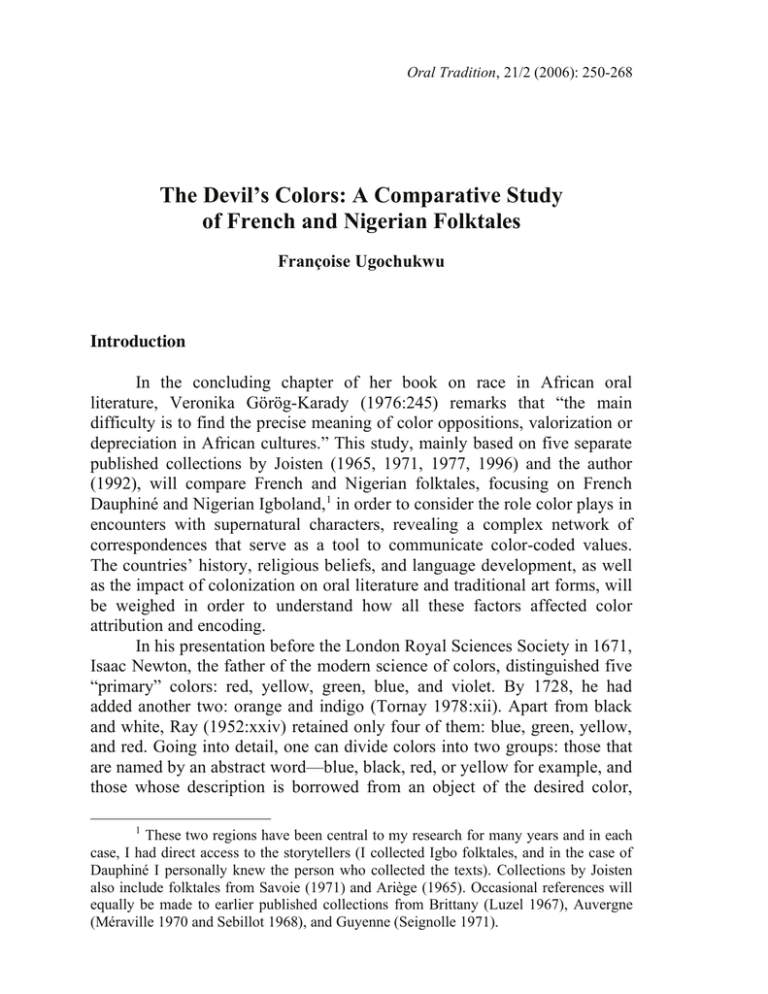
Oral Tradition, 21/2 (2006): 250-268 The Devil’s Colors: A Comparative Study of French and Nigerian Folktales Françoise Ugochukwu Introduction In the concluding chapter of her book on race in African oral literature, Veronika Görög-Karady (1976:245) remarks that “the main difficulty is to find the precise meaning of color oppositions, valorization or depreciation in African cultures.” This study, mainly based on five separate published collections by Joisten (1965, 1971, 1977, 1996) and the author (1992), will compare French and Nigerian folktales, focusing on French Dauphiné and Nigerian Igboland,1 in order to consider the role color plays in encounters with supernatural characters, revealing a complex network of correspondences that serve as a tool to communicate color-coded values. The countries’ history, religious beliefs, and language development, as well as the impact of colonization on oral literature and traditional art forms, will be weighed in order to understand how all these factors affected color attribution and encoding. In his presentation before the London Royal Sciences Society in 1671, Isaac Newton, the father of the modern science of colors, distinguished five “primary” colors: red, yellow, green, blue, and violet. By 1728, he had added another two: orange and indigo (Tornay 1978:xii). Apart from black and white, Ray (1952:xxiv) retained only four of them: blue, green, yellow, and red. Going into detail, one can divide colors into two groups: those that are named by an abstract word—blue, black, red, or yellow for example, and those whose description is borrowed from an object of the desired color, 1 These two regions have been central to my research for many years and in each case, I had direct access to the storytellers (I collected Igbo folktales, and in the case of Dauphiné I personally knew the person who collected the texts). Collections by Joisten also include folktales from Savoie (1971) and Ariège (1965). Occasional references will equally be made to earlier published collections from Brittany (Luzel 1967), Auvergne (Méraville 1970 and Sebillot 1968), and Guyenne (Seignolle 1971). FRANÇOIS UGOCHUKWU 251 such as orange, lime, plum, lilac, cream, violet, or saffron. Over time and especially since the industrial revolution, color terms have undergone a tremendous evolution and expansion, prompted by technological advancement and specialization in chemistry and textile manufacturing. Since Gladstone’s study of Homer’s use of colors in 1858 attracted further attention to color terms, those have “probably (been) the most intensely investigated words in linguistics, having been studied in over three hundred of the world’s languages” (Zollinger 1999:9, 127), mostly from Europe and the Americas. In modern French, the vocabulary of colors is rich and varied, with many hues. The Igbo language, one of Nigeria’s three national languages,2 illustrates Davidoff’s point that “languages…have problems with color names” (1991:150). Igbo has a name for most basic colors, but an abstract word for only two––black and white, while the rest are named after an object that either has that color or images it: green is “leaf,” red is “blood,” yellow and purple draw their names from tinctorial plants, and grey is “ash.” Verbs associated with colors3 include some extra dimension of beauty, and brightness in the case of white. In Igbo, “she is black” takes the form of “she is handsome-black” (o na-eji ojii), and “he is white” is “he shines white” (o na-acha ocha)—this last verb, associated with both “warmth” and “glow,” is used for all colors except black. Although the language includes no word for either “blue” or “brown,”4 it does have words for “indigo”—referring to the tinctorial plant producing a near-black color—and for “sky”—designating its location rather than its color. Pale blue is generally perceived as green, orange and light brown as yellow, and dark blue and brown as black,5 2 Nigeria possesses 510 living languages (www.ethnologue.com), with the three majority languages Hausa, Yoruba, and Igbo, having been promoted to the status of national languages in the 1970s and being taught at all levels in the country. Igbo vocabulary has seen a rapid expansion since the 1960s, thanks in particular to the work of its University-led Standardisation Committee that has been steadily expanding Igbo vocabulary by borrowing from the various dialects and coining from other languages. 3 Verbs associated with colors are central to Igbo language. 4 The word for “rust” has now been adopted to describe “brown” (SPILC 1985:48). 5 Davidoff (1991:153) suggests that “in fact, blue is rare in nature, which might account for its relative scarcity as a color term.” Tornay (1978:xlii), however, offers an indirect explanation for the absence of an Igbo word for “blue.” Quoting Bornstein’s studies, he notes that the recorded high optic yellow pigmentation in equatorial regions corresponds to a high frequency of linguistic fusion between green and blue in these FRENCH AND NIGERIAN FOLKTALES 252 according with Goethe’s opinion (1840:311) that blue had an affinity with black.6 Folktales from both countries could have benefited from such an available and growing vocabulary. Yet this study of more than 300 texts found them to be rather colorless, except for the occasional mention of white and black, and also red and green, those colors most easily captured by the eye (Tornay 1978:xix); other colors hardly ever appear in the texts. This situation leads one to question the role and interpretation of colors in folktales, a field that has seldom attracted attention so far, apart from GörögKarady’s work (1976) on the image of black and white in African oral literature and focusing on the relationship between Africans and Europeans.7 Supernatural Encounters We will first look at the texts in order to summarize data and highlight their variety and ambivalence, meeting a number of characters in the process. The most prominent supernatural being encountered in France, whatever the region, is the devil.8 Storytellers from Réotier (Upper Alps) variously describe the devil as a young man dressed in a monk’s black frock or as a black man with red lips and protruding eyes, or as a handsome Caucasian male dressed partly in white and partly in red, or as a red-haired man (Joisten 1977:332) that lives in the thick of the forest or up a mountain that can be black, red, or green—usually green in southern France and black in the northern part of the country (Ugochukwu 1986:105, 108, 110). Although the devil is most often associated with black—a huge black man in zones, suggesting a geographical and genetic influence on color perception and naming. The so-called confusion or assimilation between green and blue has been noted elsewhere; in China, for example, green and blue both seem to be given the name ts’ing (Gernet 1999:298)—yet the Chinese language has three words for that combination. In reality, each culture perceives the spectrum continuum and divides it into arbitrary units, with sometimes only one name for the whole color zone (cf. Ray 1952:258-59). 6 This proves the controversial nature of Berlin and Kay’s color scale (1969), and supports Zollinger’s opinion (1999:129) that terms for color, brightness, and hues are not universally equivalent. 7 Very few studies touch on this subject; see Bolton and Crisp 1979 as well as Ugochukwu 1979. 8 His presence in folktales can be explained by the early introduction of Christianity in the country. 253 FRANÇOIS UGOCHUKWU a folktale collected in 1896 (Teneze and Abry 1982:186)—he likes other colors as well, appearing dressed in green (ibid.:31) or in a red coat, or as a little red man springing out of the hearth flames who later turns into a young lord clad in blue (Joisten and Joisten 1986:66). A legend from Bessans (Savoy), published in the Almanach du petit dauphinois in 1936, mentions a red demon who disappears in a green, sulphur-smelling flame (ibid.:85). In a variant, this creature is wrapped in a black mantle (88), just as frescoes from the Bessans church represent the devil as yellow and black in the midst of red flames (74). Oral literature from both France and Nigeria records encounters with other supernatural beings and details their appearance. In Guyenne, Saint Peter is white-bearded (Seignolle 1971:79); Dauphiné fairies, the “fayes,” are women dressed in white (Abry and Joisten 1992:13). Ghosts of the dead are wrapped either in a white shroud or in black linen (ibid.:59). Van Gennep records that, in Brittany, dwarfs carry huge and deformed heads over stunted black bodies (Teneze and Abry 1982:215). The “naroves” of the Jura legends, wild malevolent beings, are stocky and black-faced, and run bare-foot covered in rags (ibid.:260). Another evil being, the bogeyman, invisible except for his hand and black or green in Dauphiné folktales, drags children into torrents, wells, and abysses (Joisten 1996:231). And there are reports about green, yellow, and blue horned demons (Joisten and Joisten 1986:86). In Igboland, white is traditionally associated with ancestral spirits, as testified by G. T. Basden’s (1938) photo of an Igbo initiate’s ceremonial body-painting with one side painted white, the combination representing his being half-man, half-spirit. Many of these spirits are associated with animals of the same color, as they either take their form, appear in their company, or require them as sacrifices. Such spirits include black or white snakes (Ugochukwu 1992:94; Teneze and Abry 1982:37) and cats of all colors according to a legend from Saint Maurice en Valgaudemar (Upper Alps), but mostly black as noted in Dauphiné folktales (Teneze and Abry 1982:114; Joisten and Joisten 1986:64) where the devil manifests himself as a black dog or cat, with black cats or black chickens used as sacrifices to attract him. Folktales may also display a series of white animals: horses that carry their rider into a flowing river, pigeons and doves that help the hero (Teneze and Abry 1982:215; Bettelheim 1976:137), and chamois glimpsed by a dying hunter (Joutard and Majastre 1987:29). FRENCH AND NIGERIAN FOLKTALES 254 Beauty, Darkness, and Light In the widespread Igbo folktale of “Enendu,” the ogres who decide to kill their adolescent visitor smear his face with white chalk and that of their own child with grey ashes. The aim is to enhance the color of the fair one, whose fairness is read as a threat, in order to facilitate his nighttime capture; but Enendu clears the chalk off his face and smears it with ash instead—this will result in his being spared (Ugochukwu 1992:183). In another folktale, the orphan’s body color is enhanced by the water spirit smearing it with indigo (ibid.:197). Widely used before the introduction of modern cosmetics, indigo dye confirms black as the color of beauty (Basden 1938:330) while the bright darkness of the skin clearly marks the girl as human as she moves into the spirit world for a dancing contest. The Bible records that the devil can masquerade as an angel of light (2 Cor.11:14), and Newton’s experiments led him to recognize the relationship between color and light. Brilliance is what sets colors apart (Tornay 1978: xii; Zollinger 1999:5), while giving them a religious polarity—in Igboland, masquerades and mermaid dances, commonly associated with white, employ many mirrors stuck on brightly colored cloth. In the Igbo language “shining” does not necessarily mean that one is fair in complexion—it is more accurately associated with beauty, more precisely a beauty that oozes out of the skin and owes little to color. It would therefore seem that folktales are more or less told in shades of black and white, with French folktales including additional references to red, green/blue, and yellow—all associated with the supernatural and endowed with an ambivalent polarity that can be measured on the following double scale, usually (but not always) read from the positive (left) to the negative (right): / Light………………………………………………darkness/ /---------------------------/----------/-----------------/----------------/ White yellow green/blue red black9 As Zollinger explains, “color can be represented as a space . . .with continuous change in hue, brightness and saturation” (1999:127). The same scale is then used to interpret appearances of human and supernatural beings, with the devil at the extreme right of the scale in French folktales and the 9 Cf. Goethe’s discussion of color polarity (1840:276 n.696, 304-15). FRANÇOIS UGOCHUKWU 255 spirits of the dead at the other end in both countries, no matter how they behave.10 Between Heaven and Hell Black and white have been considered as constituting two opposite poles, with red standing somewhere in between. These three colors seem to be the most prominent and universal in all languages, possessing an ancient and powerful symbolism (Verity 1980:113). In French oral literature, the red color associated with the devil is directly inspired by the fire and flames of hell,11 and illustrates the fact that the appreciation and reading of colors has been heavily influenced by traditional/popular and imported religions. In France, folktales record an overwhelming influence from Catholicism and the Bible, which have given white its positive connotation—associating it not only with snow but with cleanliness, innocence, and beauty—while equating black with evil, as further evidenced by French and English expressions such as “black soul,” “black magic,” “black market,” and “dark secrets.” Nederveen Pieterse comments (1992:196): “In a . . . perspective in which ‘clean,’ ‘white,’ ‘fair,’ ‘light,’ ‘good’ go together as the foundation of aesthetics and civilization, it is obvious that ‘dark,’ ‘black,’ ‘dirty,’ ‘sinful,’ ‘evil’ will be grouped together as well.” Interestingly, the same reading of white prevails in Africa, both in the language and in folktales, in spite of the fact that those are laden with traditional beliefs. Whenever she appears in folktales, the Virgin Mary is white,12 and folktales and popular culture usually highlight the beauty of fair women, as 10 Considered to produce “the most significant impression that color has made on the human mind, probably on every culture on earth” and as a pathway to the other world (Zollinger 1999:21-22), the rainbow, with its array of colors, moves across the spectrum and warns against a hasty reading of color symbolism. A potent biblical symbol in Genesis, it is also revered in popular religion, as proved by both Igbo folktales and French cemeteries (Joisten 1977:305, Joutard and Majastre 1987:95, 228). 11 According to Joisten (1996:177), the devil “is the only important supernatural being who presents the same characteristics in both folktales and hagiographic literature.” 12 Some other expressions of popular religious culture, such as ex-votos, record a shift in color-coding, with the veneration of black Virgins, also called “Saracens,” in sanctuaries mostly situated in the southern part of the country and on its southern borders (cf. Joisten 1977:213-45). This inversion might have been linked to the medieval crusades or gypsy hagiographic legends, but might as well be a reminder of the ancient chthonian fairies that haunted the woods, fountains, and caves in pre-Christian traditions. FRENCH AND NIGERIAN FOLKTALES 256 proved by the stories of Snow-White and All-kinds-of-fur (Grimm and Grimm 1976: 144, 201). In Igbo folktales and culture, the fairer a girl or a woman is, the closer she is to the spirits. Igbo masks that represent young, unmarried girls always have a white face (Basden 1938:368). In addition, white is the favorite color of the mermaid cult, associated with white handkerchief dancing, mirrors, and the presentation of white objects and fowl to the River spirits, a fertility cult prevalent all along the West African coast and the River Niger. Adepts describe mermaids or Mami Wota as both fair and European in appearance, with long, flowing hair, as described in “Uncle Ben’s Choice,” one of Chinua Achebe’s Girls at War short stories (1986:79), or in Nigerian videos that depict folktales and popular religion. African myths collected by Veronika Görög-Karady (1976:220) equally associated white Europeans with water spirits.13 White, the color of water cults, has also been used as an alternative and a substitute for black as a mourning symbol, with expressions like “white as a sheet” evoking both the shroud that envelops the corpse and the whitish, bodiless ghost. In the course of the Igbo ozo title-taking ceremony,14 the incumbent’s body is smeared with white chalk to signify his being ushered, through spiritual death, into the spirit world (Basden 1938:138). Oral tales from Congo record that the dead turn white, explaining their loss of pigmentation by their long sojourn in water (Görög-Karady 1976:219). In the Igbo folktale “The Son of the Rainbow,” white is associated with cruel, merciless spirits. A child’s quest for his departed father brings him and his mother to the river spirit who asks her to return to the riverbank with her child, a white clay pot, a white piece of cloth, and other white objects, seven in all. She obeys. Once there, she sings a lament, at the end of which the child falls into the water and drowns (Ugochukwu 1992:227-33). Customs and traditional rites associate both black and white equally with death, as in Igboland where pieces of white cloth are traditionally brought to the deceased’s house by visitors,15 while mourners dress in either black or white. The colors of mourning clothes are the same in traditional Savoy— black for the family, white for the poor invited to the bedside, with blue worn as a substitute for black toward the end of the mourning period (Milliex 13 This could be explained by the fact that Europeans came from the sea, and then into Igboland by boat on the river Niger. 14 The highest and most revered political and religious title in Igboland. 15 The same custom is attested by Bambara tales (Görög-Karady 1976:248). FRANÇOIS UGOCHUKWU 257 1978:144-46), a reminder of the previously mentioned closeness of black and blue. As for the green attire that the devil sometimes wears in French folktales, green is the hunter’s color—a tradition dating from medieval times that announces him as hunting for souls to trap in the fires of hell (Tenèze and Abry 1982:31). The yellow/green color can equally be read as an image of sulphur, whose stench traditionally envelops the devil’s apparitions; the same connotation is attested in the traditional Candlemas rite16 when French rural parishioners brought green candles to church for them to be blessed in order to protect their homes from lightning (Walter 1992:237). As for red, when associated with black its traditional symbolism is reversed and, instead of ardent love, it then means hatred (Verity 1980:114). History as Source and Key to Color-Coding According to Bonte and Izard (2002:779), perceptual categorizers are universal and only serve as a reference; culture-coded symbolism then uses them as primary material to build on. In the end, what matters is not the color itself but the way it is read. Goethe’s opinion was that “we associate the character of the color with the character of the person”; he personally considered the “white man” to be “the most beautiful” (1840:328 n. 839, 265 n. 672). In Europe, as in Africa, history has been the major factor of transformation in the reading of colors. In that regard, the impact of religious beliefs upon the reading of colors cannot be separated from historical influences, as world events like the crusades and colonization went hand in hand with the spread of missionaries. Although Catholicism brought about a radical change in European reading of color (Verity 1980:113), [t]he symbolism associated with light and darkness was probably derived from esoteric tradition—astrology, alchemy, Gnosticism and forms of Manichaeism. For the alchemist, spiritual evolution proceeded from the prime, black matter, associated with fermentation and putrefaction, to the white mercury, standing for illumination, ascension and revelation, culminating in the red sulphur, suffering, sublimation and love, to achieve gold. 16 Candlemas is the Christian version of an ancient Celtic Feast celebrated in honor of the fertility goddess Imbolc at the mid-point between the winter solstice and the spring equinox. The day takes its name from the rite. FRENCH AND NIGERIAN FOLKTALES 258 In itself, none of that process had anything to do with skin color, but in the course of time, and as early as the fifth century C.E., it did acquire that connotation: “black became the color of the devil and demons” (Nederveen Pieterse 1992: 24). This attitude was later reinforced by European confrontation with Middle Eastern Islam and the transfer of black demon symbolism to the Chanson de Roland, where Moslems appear “black as melted pitch.” Threatened by heresies, confronted by Islam, the thirteenthcentury Christian world gathered itself against strangers considered as monsters, those branded as “satanic” (Delacampagne 2000:80) and promised to destruction. In the sixteenth century, the introduction of black servants into European courts further reinforced that reading, while a tendentious interpretation of the Bible and of Ham’s curse (Genesis 9:25, 10:6) was used to rubber-stamp this negative color coding.17 On the part of Africans, interaction with the Portuguese and nineteenth-century colonization brought about, on the one hand, assimilation between white, water, beauty, power, and riches, and, on the other, between light and religious purity.18 Yet other, negative connotations came into play, no doubt brought about by the colonial experience, connotations that match the ambivalent character of the spirits, as already noted by Görög-Karady (1976:240). In Igbo language, for example, white is associated with laziness (ura ndi ocha = the “white sleep,” that is, a lie-in, sleeping at a time when one is expected to be awake and busy working) and alienation (oru oyibo = “white work,” initiated by the white and destined to benefit them only, that is, nobody’s job, a job that neither benefits nor concerns workers). Such expressions widen the gap between blacks and whites. On the other hand, Igbo language does not restrict the term “white” to Europeans but extends it to fair-skinned Igbo and even albinos19—although in Nigerian English, these last two groups are more likely to be called “yellow.” This could be construed as indicating a tendency to merge/assimilate all shades of white. More importantly, the same color is also applied to those considered to behave like the stereotypical European. 17 The same color difference was to be crucial in the later massacres of Native Americans and in justifying the transatlantic slave trade. 18 Research in psychology has found traces of these mental pictures in AfricanAmerican children who overwhelmingly showed their preference for white dolls, whose color was found more attractive (Nederveen Pieterse 1992:11). 19 Apart from that term, Igbo language has a specific word for “albino” that indicates the skin condition and not necessarily the color. FRANÇOIS UGOCHUKWU 259 Whereas African traditional beliefs tended to associate white people with magic and supernatural powers, traditional natural history (ibid.:43) has often associated blacks with animals, and that has had a lasting effect. Europe built a profile of the African as someone “primitive,” “savage,” bestial, living in his impenetrable jungle, and this image is associated with those of nudity and wild dancing. Blacks’ profile “match[es] those of animals, criminals, mad people, degenerates (. . .), a world of monsters and demons, which . . . must be controlled” (ibid.:179-80) or even destroyed (Delacampagne 2000:201). Dauphiné folktales of “The Three Cats,” “The Soapy Mountain,” “The Three Lemons,” and “The Five Oranges” (Joisten 1971:29-40, 137-39, and 141) further prove this point. In the tale of “The Three Cats” (Joisten 1996:202), three brothers leave home in search of the perfect spouse. The youngest checks into an inn whose keepers are three ladies turned into female cats, while the two other brothers travel to China and Cochin China, Senegal, and Equatorial Africa. The folktale describes the two African women they bring back: one is chained, with a ring passed through her nose; the other is a “plated negress” who carries her baby on her back and feeds him by throwing her 60 cm. breasts backwards, a description reminiscent of those of wild fairies found in folktales from Upper Savoy. The other Dauphiné folktales mentioned above do present young, unmarried women, white, yellow, or black. The white one is the only one with a name, an avowed Catholic faith and training in good manners, the only one who can hold a conversation and offer help; the black women are again compared to wild untamed animals or presented as wicked jealous witches. Spirits as Strangers The color attributed to evil spirits in folktales and in the culture is globally opposed to that of the locals, that is, white for Nigerians, black for the French, whereas spirits perceived as good—the Virgin Mary, angels, fairies, and God20—are usually the same color as the people, even fairer. The devil is an enemy on two counts: first by status, because he is a spirit, therefore different, the great stranger, whose difference must be highlighted; and secondly by character, because he is perceived as inherently evil. Whoever is different therefore becomes the devil, and if foreigners are black, then the devil is black. Although popular religion and the belief in familiar spirits bring the French close to the Igbo, the relationship between humans 20 A tale told in one of the Nigerian videos is entitled God is African (see Filmography). FRENCH AND NIGERIAN FOLKTALES 260 and spirits is different in the two cultures considered. In the French tradition, the world of spirits is close yet rather feared and characterized by a clear duality: God and the saints are good; the devil and demons are bad. In the middle, we find familiar spirits and the ghosts of purgatory souls, whose status is rather ambivalent yet inoffensive. In Nigeria, while spirits are clearly discerned as different, encounters with them are common and reveal these beings as human-like in character—ambivalent and unpredictable, having feelings and capable of both the best and the worst. What differentiates them, in the end, is thus more their spirit status than their character. It follows that in folktales the giving of a color or a shape to a person is not a reflection of reality:21 it only tags the person or object as alien. Color has therefore no inherent value—it is only used as a marker of identity. Allocating a color to persons/objects amounts to extracting them from the unknown, taming them, pre-empting the harm their interaction could inflict, and disabling them by classifying them within cultural parameters. The disguise one observes in folktales, with the devil and other evil spirits opting to change their color/appearance in order to appear human, is a rejection of the categorization that would prevent them from interacting with people— just as concealment through color change is widespread in the animal world, from fish to chameleon. A folktale from Guyenne, for example, combines body and color change: on his way back from the pub, a drunken farmer meets a white dog and tries in vain to get rid of it. The dog follows him home, jumps into his bed, and holds him tight while he sleeps. In the morning, the man’s wife discovers her husband strangled, still in the clutches of a black, hairy devil (Seignolle 1971:229-30). Masquerades, whether in Switzerland or in Nigeria, also reveal people camouflaging themselves with soot, wooden masks, and cloth to embody ancestral spirits, and changing color and shape in order to interact with those spirits. Color is thus an essential tool of both categorization and communication, as color symbolism is known to be instantly read and decoded within cultures. It could further be argued that storytellers 21 Traditional dress-code in both countries made little use of color. In the Alps, for example, local dress was usually made of cotton or wool, and rather dull—except for shawls and headgear, clothes, even wedding gowns, were always dark (Arnaud 1983:68), both black and white being worn for mourning in France as well as in Nigeria. FRANÇOIS UGOCHUKWU 261 deliberately choose to limit the number of colors they use in order to highlight their importance.22 Alternative Readings Human beings have been described as visually oriented animals, and color has long been recognized as a dominant factor in visual perception (Verity 1980:68 and 106). Didactic in nature, folktales capitalize on that connection, with the words of the storyteller adding shape to characters’ color. Whereas supernatural beings such as God, angels, the Virgin Mary, the saints, or the ancestors are usually presented as handsome or at least good-looking, Igbo evil spirits,23 which mostly populate folktales, are always given an ugly face. As for the devil and his demons, they usually have an ambivalent appearance that distinguishes between their real appearance and their cover. The devil often disguises himself as a handsome, well-dressed, dandy-like, fair-faced young man—”camouflage breaks up the shape, outline and shadow . . . making [him] blend with [his] general background” (ibid.:75). He can also change into a variety of animals: cats, dogs, horses, or goats. When found out, he turns into a repulsive semi-animal being, half man and half goat; his face is ape-like with protruding lips and eyes; his legs are those of a goat, horse, cock, or cow; he has a tail, horns, or bat’s wings (Joisten and Joisten 1986:74 and Joisten 1996:177); or the devil is hollow with a back devoured by worms and snakes (Teneze and Abry 1982:31). His specialty is the disguise, achieved either by covering himself with a large cape or mantle or by changing into other beings. In folktales and legends, supernatural beings as a rule do not disclose their real selves; they use another body, cover themselves, or don a mask (as we just saw with the devil)––masks embodying ancestral spirits (Chappaz-Wirthner 1974:63) variously called ancestors, ghosts, spirits, or demons. God disguises himself too, usually as a ragged old man, and fairies take the features of old women. These appearances can be interpreted as substituting bodily shape for color-coding, in the same way that objects are named to conjure a color. Igbo folktales present evil spirits with two or more heads, or even heads all 22 This would contradict Zollinger’s findings of “a significant, positive association between the relative salience of color categories in folktales and in the Berlin and Kay evolutionary sequence” (1999:150). 23 Spirits of the deceased who, for various reasons, were prevented from accessing the ancestors’ place of rest and are left to roam endlessly on the frontier of the land of the living. FRENCH AND NIGERIAN FOLKTALES 262 over their bodies (Ugochukwu 1992:23-29). These heads are often hollow, filled with fire, smoke, lakes, or reptiles (ibid.:93-97). One of the spirits is halved (257). This interpretation is corroborated by available studies on masquerades: according to Chappaz-Wirthner (1974:64), records dating back to the fifteenth century attest that, prior to the wearing of masks, people’s faces were smeared with black soot or ashes. Lötschental masks were later carved and painted, first with red, black, and white, obtained from blood, soot, and flour (ibid.:40) before artists reverted to black, shapes now being read in conjunction with colors. Whatever the type of difference highlighted by folktales—deformity or darker skin—the message is the same: “acceptable” human beings look like you and me; they share our skin color and our features and are therefore deemed acceptable, as corresponding to our canon of beauty. Foreigners, however, look different; they are perceived as animal-like or monstrous, and the reading of their features justifies their separation and facilitates their rejection. That is why the miller’s wife rebukes the devil with this exclamation: “What are you here for? Blacks are not welcome here!” (Méraville 1970:158).24 One must say that the message from folktales is not always that clear, in that “one way literature projects its knowledge and thought is through . . . allegory” (Fletcher 1991:93). There are a number of reasons for the encoding of the message. Folktales are part of oral literature, a heavily encoded lore as one can verify from the study of traditional songs. As such, they aim at a mixed audience and thus offer several layers of meaning, which each group deciphers with the help of the social keys available to it–– children usually take the text at face value, while adults and initiates read far more into it. The encoding allows the message to be delivered indiscriminately while still respecting cultural taboos. Such a rendering finally excludes outsiders, who may not possess the cues that would enable them to understand the whole meaning of the tale. The same applies to color terms; used “with a belief in their power to communicate” (ibid.: 101), they do so, yet selectively. 24 Igbo culture does have a regard for some disabilities, as we can see in folktales and in the Nri culture. In Igboland, dwarfs have long been associated with the Nri kingdom, the first and oldest of kingdoms, which controlled Igbo traditional religion. Regarded as mystical beings and much revered, these dwarfs were sent to the king, who used them as his attendants and messengers (Onwuejeogwu 1981:90). FRANÇOIS UGOCHUKWU 263 Do Colors Really Matter? Most of the representations that guide our personal and social behavior are built using the diversity of our sensorial experience—taste, hearing, smell, touch, and sight (Tornay 1978:l). To color space, in particular, is to throw light on it, extracting it from chaos and giving it a meaning. Black and white have often been considered as non-colors, marking a space where the absence or the profusion of light blurs all details and shapes. This practice could explain why folktales use these colors to describe aliens whose features cannot easily be read. Other colors—yellow, green, or red—serve as references, linking the person/object to one of the accepted symbols: red, for example, being usually associated with passion, danger, interdiction, violence, blood, and hell, while green has always been the color of nature and wild, untamed territory.25 Folktales, which gather their audience as night sets in, appeal to sensorial experience and associate colors, shapes, and smells with music and vocal performance, yet encourage us to go beyond the visual and read colors to understand them as signposts and keys to the truths that lie beyond. The folktale of “The Rat and the Pregnant Woman” (Ugochukwu 1992:248-55) illustrates the ultimate reading of colors in Igboland. It is about a pregnant woman who lives on the edge of the forest. Although she has all she needs, she always craves caterpillars (a delicacy). She eventually discovers a tree full of them and keeps going there in the hope of gathering some, but fails because of her bulging tummy. After begging all the animals in vain for help, she meets the speckled rat, who not only fills her basket but keeps bringing caterpillars to her daily until she gives birth to a baby girl. She must hand over her daughter to him in marriage, so goes their agreement, and, in due time, the mother rejects all suitors, repeating that she will give her daughter only to a speckled animal. Here, in spite of appearances, what counts is not the skin color but the person’s behavior. The rat’s assistance has led to his appearance being awarded the price of his good deeds—this is the lesson of folktales. Open University United Kingdom 25 Davidoff (1991:115) warns that anthropological evidence encourages caution, since such associations have proven to be far from universal. FRENCH AND NIGERIAN FOLKTALES 264 References Abry and Joisten 1992 Christian Abry and Alice Joisten, eds. Etres fantastiques des Alpes—Recueil d’études et de documents en mémoire de Charles Joisten (1936-1981). Grenoble: Centre Alpin et Rhodanien d’Ethnologie. Achebe 1986 Chinua Achebe. Girls at War. London: Heinemann. Orig. publ. 1972. Arnaud 1983 Claude Arnaud. Une mémoire de Saint-Véran: Vie traditionnelle et patois queyrassins. Grenoble: Centre Alpin et Rhodanien d’Ethnologie. Basden 1938 George Thomas Basden. Niger Ibos. London: F. Cass. Rpt. 1966. Belmont 1982 Nicole Belmont. “Croyances populaires et légendes: A propos d’un dossier inédit d’Arnold Van Gennep sur les êtres fantastiques dans le folklore français.” In Teneze and Abry 1982:211-19. Berlin and Kay 1969 Brent Berlin and Paul Kay. Basic Color Terms: Their Universality and Evolution. Berkeley: University of California Press. Rpt. 1991. Bettelheim 1976 Bruno Bettelheim. Psychanalyse des contes de Fées. Paris: Robert Laffont. Bolton and Crisp 1979 Ralph Bolton and Diane Crisp. “Color Terms in Folktales: A Cross-Cultural Study.” Behavior Science Research, 14:231-53. Bonte and Izard 2002 Pierre Bonte and Michel Izard. Dictionnaire de l’ethnologie et de l’anthropologie. Paris: Presses Universitaires de France. 2nd ed. Bornstein 1973a Marc Bornstein. “Color Vision and Color Naming: A Psychophysiological Hypothesis of Cultural Difference.” Psychological Bulletin, 80:257-85. Bornstein 1973b . “The Psychophysiological Component of Cultural Difference in Colour Naming and Illusion Susceptibility.” Behavior Science Notes, 8:41-101. 265 FRANÇOIS UGOCHUKWU Bornstein 1975 . “The Influence of Visual Perception on Culture.” American Anthropologist, 77:774-98. Chappaz-Wirthner 1974 Suzanne Chappaz-Wirthner. Les masques du Lötschental. Présentation et discussion des sources. Mémoire de licence, Musée d’Ethnographie de Neuchâtel, Annales valaisannes. Davidoff 1991 Jules Davidoff. Cognition Through Color. Cambridge, MA: MIT Press. Delacampagne 2000 Christian Delacampagne. Une histoire du racisme. Paris: France-Culture/Librairie Générale Française. Dmitrieva 2002 Olga Dmitrieva. “Colour Associations.” www.colormatters. com/research/dmitrieva.html. d’Oliveira 1987 Boniface d’Oliveira. Expression des couleurs et des comportements sociaux: L’exemple des Fon du Bénin. Doctorat de 3e cycle, Sociologie, Paris V. Echeruo 1998 Michael Echeruo. Igbo-English Dictionary. New Haven: Yale University Press. Eliade 1965/2001 Mircea Eliade. Le sacré et le profane. Paris: Gallimard. Fletcher 1991 Angus Fletcher. Colors of the Mind: Conjecture on Thinking in Literature. Cambridge, MA: Harvard University Press. Gage 1997 John Gage. Colour and Culture: Practice and Meaning from Antiquity to Abstraction. London: Thames and Hudson. Orig. publ. 1993. Gautier 1995 Patrick André Gautier. Le rouge et le vert: Sémiologie de la couleur en Egypte ancienne. Doctorat, Histoire, Paris IV. Gernet 1999 Jacques Gernet. Le monde chinois. Paris: A. Colin. Orig. publ. 1972. Gladstone 1858 William Ewart Gladstone. Studies in Homer and the Homeric Age. 3 vols. Oxford: Oxford University Press. Gladstone 1876 . Homeric Synchronism: An Enquiry into the Time and Place of Homer. London: Macmillan. FRENCH AND NIGERIAN FOLKTALES 266 Goethe 1840 Wilhelm Goethe. Theory of Colours. Trans. into English by C. L. Eastlake. London: F. Cass, 1967. Görög-Karady 1976 Veronika Görög-Karady. Noirs et blancs: Leur image dans la littérature orale africaine: Etude-Anthologie. Langues et Civilisations à Tradition Orale, 23. Paris: Société d’Etudes Linguistiques et Anthropologiques de France. Grimm and Grimm 1976 Jacob Grimm and Wilhelm Grimm. Contes. Paris: Gallimard. 2nd ed. Igwe 1999 Georgewill Egemba Igwe. Igbo-English Dictionary. Ibadan: University Press. Joisten 1965 Charles Joisten. Contes populaires de l’Ariège. Paris: Maisonneuve and Larose. Joisten 1971 . Contes populaires du Dauphiné. Vol. Grenoble: Centre Alpin et Rhodanien d’Ethnologie. Joisten 1977 , ed. Religion populaire: Dauphiné, Savoie, Provence, Cévennes, Valais, Vallée d’Aoste, Piémont. Grenoble: Centre Alpin et Rhodanien d’Ethnologie. Joisten 1996 , ed. Contes populaires du Dauphiné. Vol. 3, completed by Alice Joisten and Jean-Noël Pelen. Grenoble: Editions A. Die and Musée Dauphinois. Joisten and Joisten 1986 and Alice Joisten. Cinq figures de magiciens en Dauphiné et en Savoie. Grenoble: Centre Alpin et Rhodanien d’Ethnologie. Joutard and Majastre 1987 Philippe Joutard and Jean-Olivier Majastre, eds. Imaginaires de la haute montagne. Grenoble: Centre Alpin et Rhodanien d’Ethnologie. Luzel 1967 François-Marie Luzel. Contes populaires de BasseBretagne. Paris: Maisonneuve & Larose. Méraville 1970 Marie-Aimée Méraville. Contes populaires de l’Auvergne. Paris: Maisonneuve and Larose. Milliex 1978 Albert Milliex. “Les coutumes familiales à St Sorlind’Arves (Savoie) au XIXe siècle.” Le Monde alpin et rhodanien, 1-2:131-46. 1. 267 FRANÇOIS UGOCHUKWU Nederveen Pieterse 1992 Jan Nederveen Pieterse. White on Black: Images of Africa and Blacks in Western Popular Culture. New Haven: Yale University Press. Onwuejeogwu 1981 Michael Angulu Onwuejeogwu. An Igbo Civilization: Nri Kingdom and Hegemony. London: Ethnographica; Benin City: Ethiope Publishers. Ray 1952 Verne Frederick Ray. ”Techniques and Problems in the Study of Human Color Perception.” Southwestern Journal of Anthropology, 8:251-59. Sebillot 1968 Paul Sebillot. Littérature orale de l’Auvergne. Paris : Maisonneuve & Larose. Seignolle 1971 Claude Seignolle. Contes populaires de Guyenne. Paris: Maisonneuve and Larose. SPILC 1985 SPILC. Recommendations of the Igbo Standardization Committee of the Society for Promoting Igbo Language & Culture. Onitsha: SPILC. Teneze and Abry 1982 Marie-Louise Teneze and Christian Abry, eds. Croyances, récits et pratiques de tradition: Mélanges Charles Joisten 1936-1981. Grenoble: Centre Alpin et Rhodanien d’Ethnologie. Tornay 1978 Serge Tornay, ed. Voir et nommer les couleurs. Nanterre: Laboratoire d’Ethnologie et de Sociologie Comparative. Ugochukwu 1979 Françoise Ugochukwu. “La femme de couleur dans les contes populaires français.” Ethiopiques, 19:92-100. Ugochukwu 1986 . “Le diable dans la tradition populaire française.” Francofonia, 10:103-14. Ugochukwu 1992 , ed. Contes igbo du Nigeria. Paris: Karthala. Ugochukwu and Okafor 2004 and P. Okafor. Dictionnaire igbo-français. Paris: Karthala. Verity 1980 Enid Verity. Colour Observed. London: Macmillan. Walter 1992 Philippe Walter. Mythologie chrétienne: Rites et mythes du Moyen-Age. Paris: Editions Entente. FRENCH AND NIGERIAN FOLKTALES Zollinger 1999 268 Heinrich Zollinger. Color: A Multidisciplinary Approach. Zürich: Verlag Helvetica Chimica Acta; New York: WileyVCH. Filmography God is African. Harrison Motion Picture. Lagos: Somaco International, 2000.
